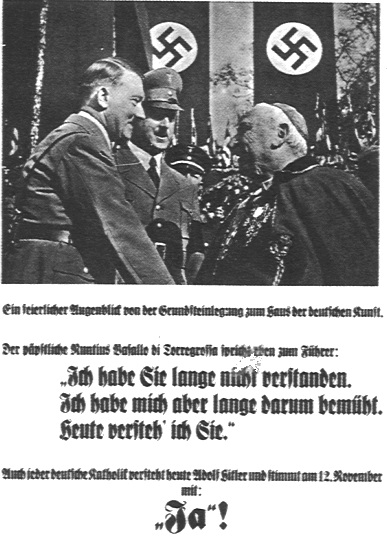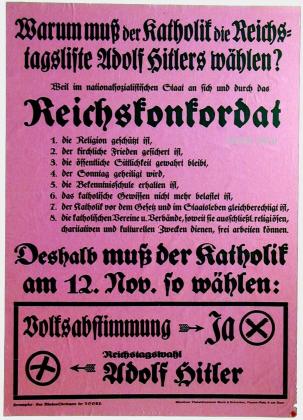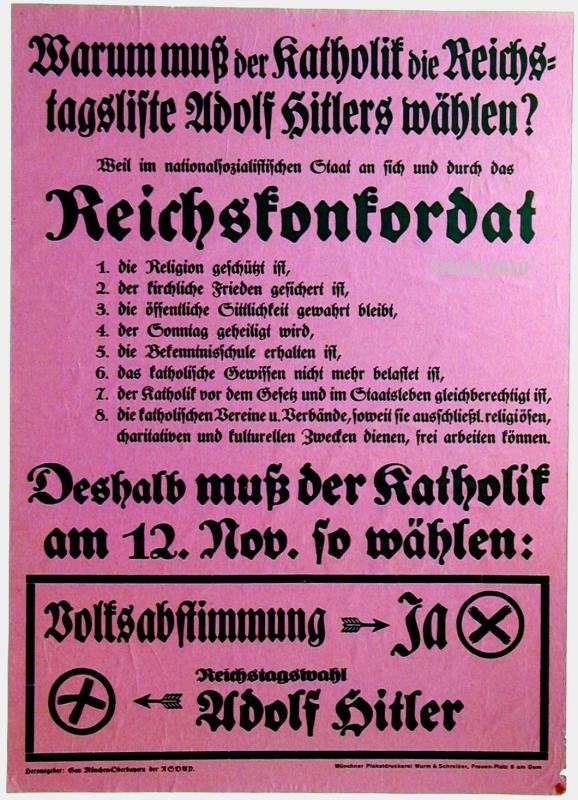Hitler�s election posters use the concordat and the papal nuncio
Hitler's 1933 election posters boast of his alliance with the Catholic Church. This refutes the claims of Benedict XVI on his 2010 trip to Britain, that atheism helped the Nazis to power. Actually, it was his own church that filled that role. It appears that already in 1933 Hitler and the pope were conspiring to send the Germans off to war to fight their common enemy, Communism.
The two posters were printed for the Reichstag election of 12 November 1933, when voters were already being presented with a single list of candidates to be approved or rejected as a group: the “Hitler list”. And it worked. The German voters had no idea that their Führer and their Pope were conspiring to send them off to war. In referendum held at the same time as the election, 93% of the unspoiled ballots approved the Nazi decision to withdraw from the League of Nations and 92% endorsed the “Hitler list”. This election doomed the Reichstag to political insignificance.
Naturally, the second poster doesn’t mention that the concordat (Reichskonkordat) also contained a Secret Supplement providing for a future German mobilisation, in defiance of the Treaty of Versailles. In fact a 1931 draft of the Austrian concordat which also contains a Secret Supplement suggests that already in 1931 the Pope expected Germany to go to war against Russia. And a recently discovered letter shows that twelve years later, when this indeed happened, Pius hoped for a German victory.
Contrary to Benedict XVI's claims that the "Nazi tyranny [...] wished to eradicate God from society", Hitler was quite happy to use the Catholic Church to control the faithful. He embraced the classic strategy of colonialism: use the people's "natural rulers" to keep them obedient to the new regime.
It was a marriage of convenience: Pius got a favourable concordat and a German army to fight Communism, while Hitler got the “Catholic vote” to help bring him to power.
Hitler's election poster uses the Papal Nuncio

A solemn moment at the laying of the corner stone of the House of German Art.
The Papal Nuncio Vassallo di Torregrossa is addressing the Führer:
“For a long time I didn't understand you.
But I have long tried to do so.
Today, I understand you.”
Today every German Catholic also understands Adolph Hitler and will vote on the 12th of November
“Yes”!
A note on the back of a copy of this poster in the Stadtarchiv Traunstein says:
»on the day of the referendum (12th Nov. 33) this poster [...was] displayed on both sides of the main entrance of the city's parish church, framed with a garland«
»dieses Plakat [...] am Tage der Volksabstimmung (12. Nov. 33) zu beiden Seiten des Hauptportals der Stadtpfarrkirche, mit einer Girlande umrahmt, aufgestellt«
Hitler's election poster uses the 1933 concordat

Why is a Catholic obliged to vote for the parliamentary list of Adolf Hitler? Because in the National Socialist state intrinsically and through the Reichskonkordat
1. The Faith is protected,
2. Peace with the Church is assured,
3. Public morality is preserved,
4. Sunday is hallowed,
5. Catholic schools are maintained,
6. The Catholic conscience is no longer burdened,
7. A Catholic has equal rights before the law and in the life of the nation,
8. Catholic organisations and associations, insofar as they exclusively serve religious, charitable and cultural purposes, can operate freely.
Therefore a Catholic is obliged on 12 November [1933] to vote thus:
Referendum: yes
Parliamentary election: Adolf Hitler
Transcriptions
Ein feierlicher Augenblick von der Grundsteinlegung zum Haus der deutschen Kunst.
Der päpstliche Nuntius Vassallo di Torregrossa spricht eben zum Führer:
„Ich habe Sie lange nicht verstanden.
Ich habe mich aber lange darum bemüht.
Heute versteh' ich Sie.“
Auch jeder deutsche Katholik versteht heute Adolf Hitler und stimmt am 12. November
mit
„Ja“!
„Warum muß der Katholik die Reichstagsliste Adolf Hitlers wählen? Weil im nationalsozialistischen Staat an sich und durch das Reichskonkordat
1. die Religion geschützt ist,
2. der kirchliche Frieden gesichert ist,
3. die öffentliche Sittlichkeit gewährt bleibt,
4. der Sonntag geheiligt wird,
5. die Bekenntnisschule erhalten ist,
6. das katholische Gewissen nicht mehr belastet ist,
7. der Katholik vor dem Gesetz und im Staatsleben gleichberechtigt ist,
8. die katholische Vereine u. Verbände, soweit sie ausschließl. religiösen, charativen und kulturellen Zwecken dienen, frei arbeiten können.
Deshalb muß der Katholik am 12. Nov. so wählen: Volksabstimmung: Ja - Reichstagswahl: Adolf Hitler“
Source: Deutsches Historisches Museum, Berlin, DHM 1988/284.41

Further reading:
A good summary of the steps by which Hitler consolidated his power has been posted by the German Government: “National Socialism (1933 - 1945)”.
http://www.bundestag.de/htdocs_e/artandhistory/history/parliamentarism/third_reich/index.html







 Hitler's concordat (1933) : Text and background
Hitler's concordat (1933) : Text and background